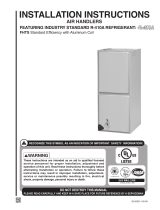
11
6. ELECTRICAL WIRING
General — Electrical power wiring must be made
in accordance with all applicable local codes
and ordinances, and with the current revision of
the National Electric Code (ANSI/NFPA 70). If
any of the original wire as supplied with the unit
must be replaced, it must be replaced with wire
material having the same gauge and tempera-
ture rating. Disconnection means: a means to
disconnect the appliance must be incorporated
in the fi xed wiring.
Line Voltage — Before proceeding with the elec-
trical connections, make certain that the voltage,
frequency, and phase of the supply source are
the same as those specifi ed on the rating plate.
Also, verify that the service provided by the utility
is suffi cient to handle the additional load imposed
by this equipment.
See the unit wiring label for proper high and low
voltage wiring. Make all electrical connections in
accordance with the National Electric Code and
any applicable local codes or ordinances.
Use a separate branch electrical circuit for this
unit. A disconnecting means must be located
within sight of, and readily accessible to, the
unit. When electric heat packages with circuit
breakers are fi eld-installed, the circuit breaker
may be used as a disconnecting means in most
applications. Reference the NEC and Local Codes
for Disconnect requirements.
208/240 volt units are shipped from the factory
wired for 240 volt transformer operation. For 208
volt operation, remove the lead from the trans-
former terminal marked 240v and connect it to
the terminal marked 208v. For maximum ampacity
and overcurrent protection, see Table 1.
Provide power supply (or supplies) for the unit in
accordance with Table 1, the unit wiring diagram
and the unit rating plate.
When a heater kit is installed: Connnect the
2 wire plug of the air handler with the mating
2 wire plug of the heater kit. Connect the line
voltage leads to the circuit breaker or terminal
block provided. Connect the heater kit plug with
the mating receptacle on the air handler control
board. When installing a 25 kw or 30 kw heater
kit, follow the instructions provided with the kit
for proper installation.
When a heater kit is not installed: Remove the 2
wire plug of the air handler by cutting the wires
and discarding the plug. Strip the ends of the 2
air handler wires and connect to the line-voltage
leads with the 2 wire nuts provided.
Use copper wire only for the line voltage power
supply to this unit. Aluminum supply wire may
be used if a heater kit is installed. Use UL listed
conduit and a conduit connector for connecting
the supply wires to the unit and for obtaining
proper grounding. Grounding may also be ac-
complished by using the grounding lug provided
in the control box. Field supplied bushings for the
power supply cables must be added to support
and protect the power supply cables.
HEATING ELEMENT LOGIC
The control board in the air handler controls the
timing sequence of the elements. Depending on
the thermostat connection, there are 2 timing
sequence variations that can be chosen. See
table 2 for element sequence timing. The board
also is equipped with a 3 second blower on delay
and a 15 second blower off delay.
WARNING:
The unit cabinet must have an uninter-
rupted and unbroken electrical ground
to minimize the risk of personal injury
if an electrical fault should occur. This
ground may consist of electrical wire
or approved conduit when installed
in accordance with existing national
or local codes.
Low Voltage — Install the grommet, which is
packed with the unit, in the hole for low-voltage
wires. When the low voltage wires are positioned
in this grommet, the grommet will prevent chafi ng
and/or shorting of the low voltage leads. Connect
the low-voltage wiring to the thermostat and the
outdoor unit and the appropriate screw terminal
located on the control board.
NOTE: Where local codes require that the
thermostat wiring must be routed through
a conduit or raceway, splices can be made
inside the unit; however, all wiring must
be NEC Class 1 and must be separated from
incoming power leads.





















